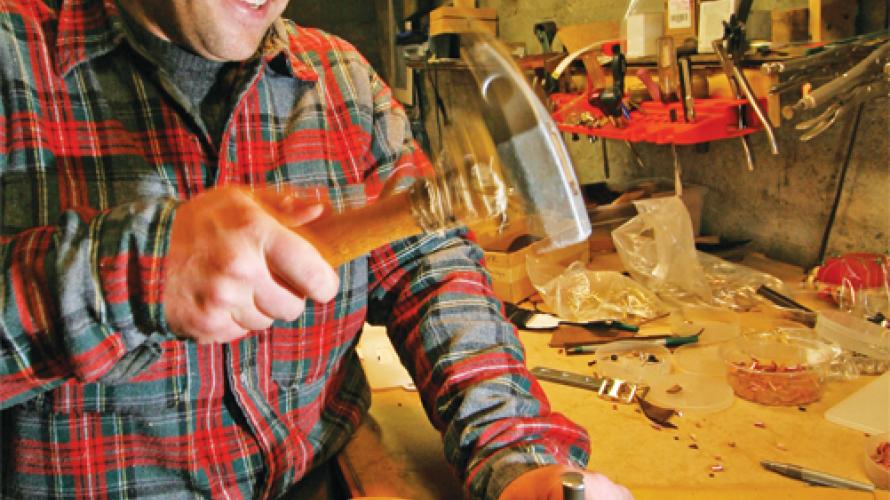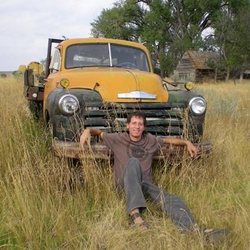
 Brian D'Ambrosio is a writer/editor living in Missoula.
Brian D'Ambrosio is a writer/editor living in Missoula.
********
Handsome leather fly fishing lanyards, river bags, and canvas backpacks are like pieces of fine art – good-looking symbols of freedom, recreation, sport, and exploration. For Joe Goertzen, they stand for something else: business. Since mid-2008, the Missoula craftsman has manufactured attractive fly fishing, hunting, and mountaineering equipment. With a sharp focus on elemental, heritage-based wares, as well as an unrelenting demand for product authenticity, Goertzen epitomizes the contemporary progressive shift from mass consumption to quality consumption.
Goertzen started out handcrafting rock climbing gear, but when that market shrank, he started tinkering with leather bags and lanyards for fly fishermen. The modification proved wise, for Goertzen’s business is now something of a showcase for attractive fly fishing accessories. What separates him from his competitors is that his fly fishing bags, knife sheaths, shell holsters, and ruck sacks mandate a greater connection between consumer and object. A connection with a global reach thanks to the technology of our times.
“It’s amazing that a tiny shop in Missoula can sell to England, Japan, and Australia,” says Goertzen, a native Kentuckian and UM graduate of Fine Arts, who speaks slowly and assertively. “It’s a good time to be a small business owner.”
Though a man of many talents, first and foremost, Goertzen specializes in leather equipment. He squeezes every drop of potential out of his brain, brawn, and saleable skills. Orders are tacked to walls; hides are stocked and organized in crates and cubbyholes. Small thumbnails of his charcoal, pen and ink, and oil on canvas works juxtapose company calendars, rough outlines, photos, and framed pictures of the outdoor adventurers who use Goertzen’s handmade crampon pouches and chalk buckets. Hand-tools, beads, sharp instruments, and strap cutters line a long workbench. Space is sparse, for each corner is occupied by a plethora of necessities, from an intricate stitching machine and a heavy leather apparatus to a large machine used to perfect canvas pockets.
If cubicles represent the dry, stale, predictable, corporate culture, Goertzen’s work arena is light on the usual amenities (the coffee pot and bathroom are upstairs), yet heavy on authenticity and fresh expression. While he scarcely deviates from preset dimensions, he uses little tricks to ensure uniqueness, such as cycling through different shades and colors. Goertzen wants his work to look very distinct, yet he knows that there is only a certain level of newness that a customer will accept. “I may add a clever twist out of the blue here and there, but overall for my products to succeed they need to have dependability, or product familiarity.”
For Goertzen to attract and excel he needs to make the right decisions in his inventory, the most important aspect of which is choosing the right type of cow hide. Dark and light brown are the two main colors of the high-grade, blemished cow hides he employs. “There is less and less leather being used these days,” says Goertzen. “That is something that is good for me. I like the nicer, thicker stuff, the real hearty stuff. I use hides that have unique indentifying traits, like branding marks or barbed wire scars. Rougher gauge leather is what I prefer to work with, not the perfect or seamless variety.”
Goertzen, who covers all his leathers with oil, has spent ample time figuring out how to bring out the character of leather, how to manipulate its imperfections into splendor, accentuate its flaws, and help turn its stains and flecks into unique sets of circumstances. It’s no small feat that he can strip, cut, measure, and stitch leather into something that is lovely to look at, yet simultaneously utilitarian enough to accessorize a serious river guide – a broadly appealing accomplishment. Interesting too because men almost always wear the gear, but it is women, says Goertzen, who more often than not make their purchases for them.
“It’s funny,” says Goertzen. “But some guys could have a million dollars in their pocket and love the lanyard, but they will not buy it. When I’m at markets or shows, much of the time it’s the women, thankfully, who have to encourage and finish the transaction.” So far anglers, guides, and hobbyists have put their support behind Goertzen’s adventure equipment.
“You feel a lot like Brad Pitt when you use Joe’s gear,” says Dan Shepherd, owner of The Grizzle Hackle fly shop in Missoula. “It’s romantic to know that Joe’s gear is made in Missoula, a city with a rich fly fishing history. People love his stuff, because it’s handcrafted, affordable, and it gets better with age.”
Encouraging signs for a guy whose bottom line as a business owner boils down to one question: Can a tiny Montana producer of a premium product get the funding and reputation he needs to survive in a mass-produced world?
“I think that as long as I can continue to find my job as stimulating as I do, and as long as I can continue to come up with the right solutions and designs, I’ll build momentum,” says Goertzen.
Entrepreneurship is an unreasonable pursuit. Founding a company – much less one that could influence the outdoor gear market – entails wild amounts of risk, intimidating chances of success and marginal work-life balance. Ultimately, however, entrepreneurship is more of an applied art than a science and Goertzen understands that in order to become big one has to first dream big.
“The North Face started out in someone’s basement or garage,” says Goertzen. “So the potential for success in this field is great. Great things happen to the right risk takers.”
